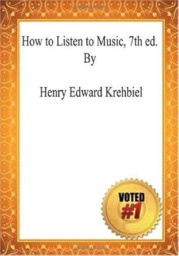

How to Listen to Music, 7th ed. (1896)
by Henry Edward Krehbiel


The fundamental principle of the instruments last described is the production of tone by vibrating reeds. In the instruments of the brass choir, the duty of the reeds is performed by the lips of the player. Variety of tone in respect of quality is produced by variations in size, shape, and modifications in parts like the bell and mouth-piece. The forte of the orchestra receives the bulk of its puissance from the brass instruments, which, nevertheless, can give voice to an extensive gamut of sentiments and feelings. There is nothing more cheery and jocund than the flourishes of the horns, but also nothing more mild and soothing than the songs which sometimes they sing. There is nothing more solemn and religious than the harmony of the trombones, while "the trumpet's loud clangor" is the very voice of a war-like spirit. All of these instruments have undergone important changes within the last few score years. The classical composers, almost down to our own time, were restricted in the use of them because they were merely natural tubes, and their notes were limited to the notes which inflexible tubes can produce. Within this century, however, they have all been transformed from imperfect diatonic instruments to perfect chromatic instruments; that is to say, every brass instrument which is in use now can give out all the semitones within its compass. This has been accomplished through the agency of valves, by means of which differing lengths of the sonorous tube are brought within the command of the players. In the case of the trombones an exceedingly venerable means of accomplishing the same end is applied. The tube is in part made double, one part sliding over the other. By moving his arm, the player lengthens or shortens the tube, and thus changing the key of the instrument, acquires all the tones which can be obtained from so many tubes of different lengths. The mouth-pieces of the trumpet, trombone, and tuba are cup-shaped, and larger than the mouth-piece of the horn, which is little else than a flare of the slender tube, sufficiently wide to receive enough of the player's lips to form the embouchure, or human reed, as it might here be named.🏁
Global Leaderboard
| # | Player | Time | Duration | Accuracy | WPM | pp | |
|---|---|---|---|---|---|---|---|
| 1 | |||||||
| 2 | |||||||
| 3 | |||||||
| 4 | |||||||
| 5 | |||||||
| 6 | |||||||
| 7 | |||||||
| 8 | |||||||
| 9 | |||||||
| 10 |


The fundamental principle of the instruments last described is the production of tone by vibrating reeds. In the instruments of the brass choir, the duty of the reeds is performed by the lips of the player. Variety of tone in respect of quality is produced by variations in size, shape, and modifications in parts like the bell and mouth-piece. The forte of the orchestra receives the bulk of its puissance from the brass instruments, which, nevertheless, can give voice to an extensive gamut of sentiments and feelings. There is nothing more cheery and jocund than the flourishes of the horns, but also nothing more mild and soothing than the songs which sometimes they sing. There is nothing more solemn and religious than the harmony of the trombones, while "the trumpet's loud clangor" is the very voice of a war-like spirit. All of these instruments have undergone important changes within the last few score years. The classical composers, almost down to our own time, were restricted in the use of them because they were merely natural tubes, and their notes were limited to the notes which inflexible tubes can produce. Within this century, however, they have all been transformed from imperfect diatonic instruments to perfect chromatic instruments; that is to say, every brass instrument which is in use now can give out all the semitones within its compass. This has been accomplished through the agency of valves, by means of which differing lengths of the sonorous tube are brought within the command of the players. In the case of the trombones an exceedingly venerable means of accomplishing the same end is applied. The tube is in part made double, one part sliding over the other. By moving his arm, the player lengthens or shortens the tube, and thus changing the key of the instrument, acquires all the tones which can be obtained from so many tubes of different lengths. The mouth-pieces of the trumpet, trombone, and tuba are cup-shaped, and larger than the mouth-piece of the horn, which is little else than a flare of the slender tube, sufficiently wide to receive enough of the player's lips to form the embouchure, or human reed, as it might here be named.🏁